Ah, to be so rich you have a literal string of pearls collection.
Or to save moola and have the plant version (arguably just as shiny and beautiful as the real thing, if not more so!).
Welcome to the enchanting world of string of pearls, an easy-going succulent that’s well-known in the houseplant world.
Its captivatingly plump, pea-like leaves cascade gracefully down its stems, evoking the elegance of a beautiful pearl necklace – and who wouldn’t want to grow their own living jewelry?
In this comprehensive guide, we’ll dive into string of pearls care, its fascinating characteristics, and the secrets hidden behind this lovely trailing curtain of green.
(Let’s explore these pearls of wisdom and get growing!)
Table of Contents
String of Pearls Care Guide
History, habitat, and characteristics
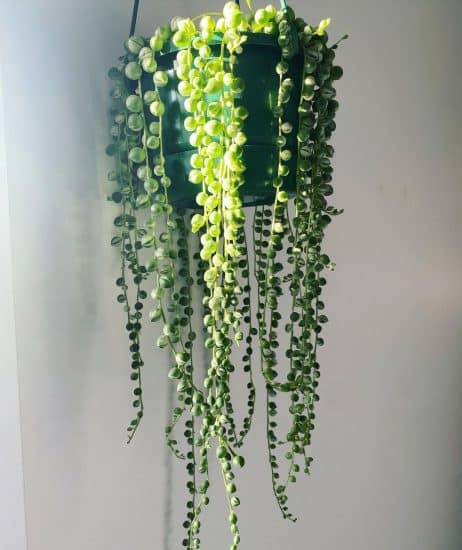
Have you ever wondered what it’s like to grow a necklace? Well, that’s kind of what it feels like with string of pearls (now Curio rowleyanus, but you might still see it mentioned as Senecio rowleyanus), named after British botanist Gordon Rowley.
A vining succulent from the Asteraceae (daisy!) family, it’s also called necklace plant, string of peas, string of marbles, string of beads… you get the idea.
With its plump, pea-shaped leaves trailing down its stems like shiny green pearls (new fashion statement, anyone?), the string of pearls plant is practically begging you to showcase it in a hanging basket.
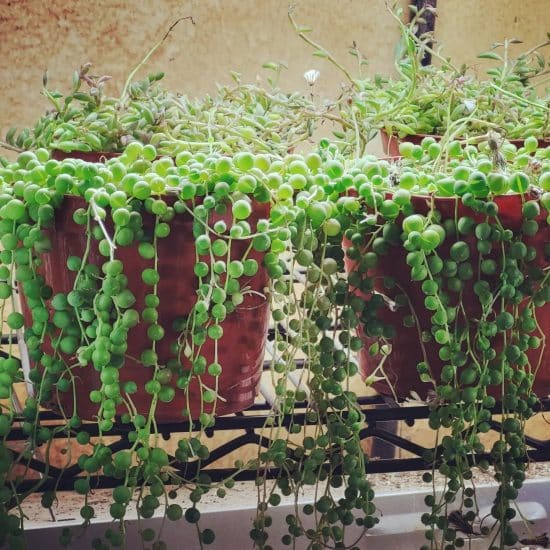
Originally from the dry and rocky landscapes of southwest Africa, where it grows as ground cover, this plant knows how to handle tough conditions. In fact, its leaves specifically evolved to be round so they would have less surface area exposed to dry desert air, helping them retain moisture.
Did you know: The sides of the pearls on your plant have a dark band of translucent tissue called an epidermal window. This opening lets light get inside the leaf, giving your plant a larger area in which to photosynthesize!
Of course, we can’t forget that our string of pearls plant happens to be related to other quirky plants in the daisy family, like:
- Curio radicans (string of bananas or string of fish hooks)
- Curio herreanus (string of watermelon or string of beads)
- Curio citriformus (teardrop leaves; small white flowers bloom in cooler months)
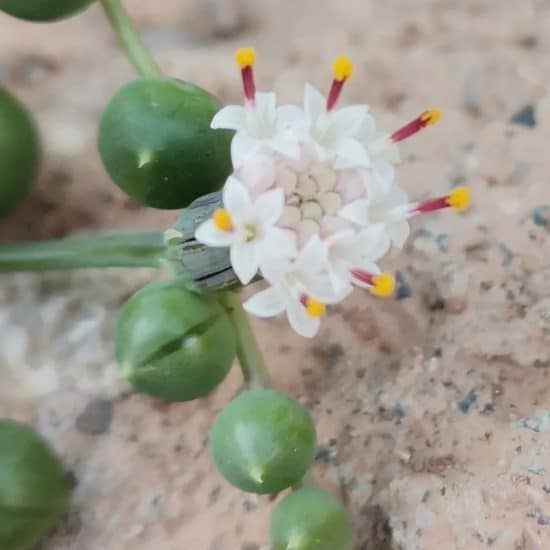
(Although it doesn’t usually bloom indoors, in the wild, string of pearls does produce white flowers that smell a little like cinnamon.)
Is there a variegated string of pearls?
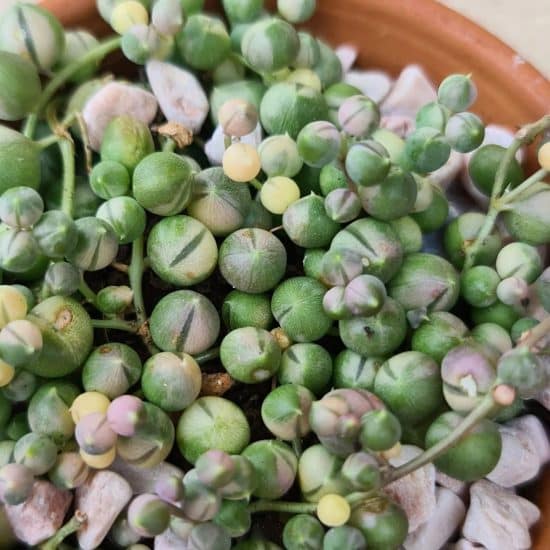
There are a few variegated string of pearls varieties. We’ve only been able to find those with white variegation, but sometimes you’ll see deep pinks and purples for sale. Be careful when buying these online because more often than not, if it looks too good to be true… it is.
Some are falsely colored, and others are just different plants completely.
Light
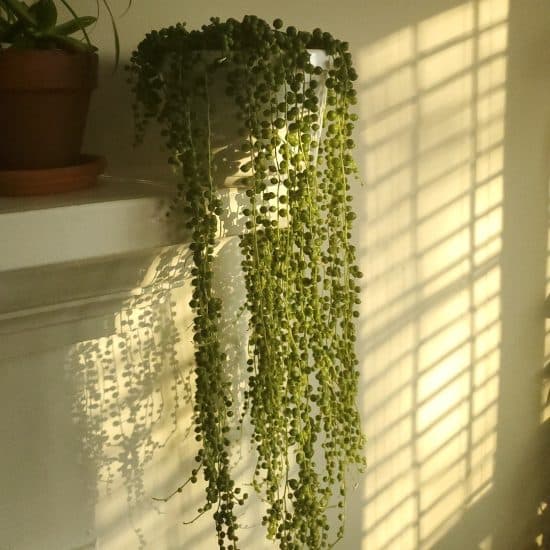
So, how do you make your string of pearls plant thick and luscious? Light is key.
The string of pearls likes a mix of direct sunlight and indirect sunlight, with morning rays being the best, paired with some afternoon shade.
Not enough light? You might notice pale leaves and stretched stems resulting in fewer pearls. On the flip side, too much direct sun can lead to sunburned leaves (ouch!).
To help your string of pearls flourish, follow these lighting tips:
- Put your plant near an east-facing window to soak up the morning sun and enjoy a bit of afternoon shade.
- If you only have south or west-facing windows, keep the plant a little farther from the window to avoid too much direct sun exposure.
- Give your plant a twirl now and then to make sure all stems get even light exposure.
- During those gloomy winter months, consider using an LED grow light (preferably full spectrum) to replace some of that missing sunshine.
Water
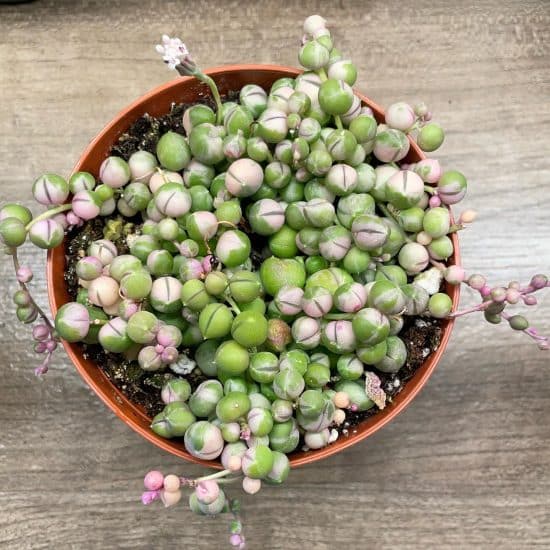
Native to the dry regions of southwest Africa, string of pearls plants are used to storing water in their leaves, which is why they’ve got such a unique appearance.
When should you give your string of pearls a drink, and how much? (Drumroll, please…) You can let the leaves or soil tell you. Leaves that need water will feel fleshy and look wrinkled.
Happy, well-watered pearls will feel firm and robust.
With succulents like SOPs, checking to see if the soil is dry isn’t always the best indication because these lil pearls can hold quite a bit of water. However, you can use a moisture meter or just stick your finger an inch or two into the soil to check when your string of pearls is in need of some water (it’ll be dry there and ever so slightly moist underneath).
That being said, we recommend letting it go a bit longer than feels comfortable. Succulents tend to like a bit of neglect.
Factors like temperature, humidity, and even the type of pot you use can affect how often you should water your plant. But generally speaking, every two weeks in summer and once a month in winter should do the trick.
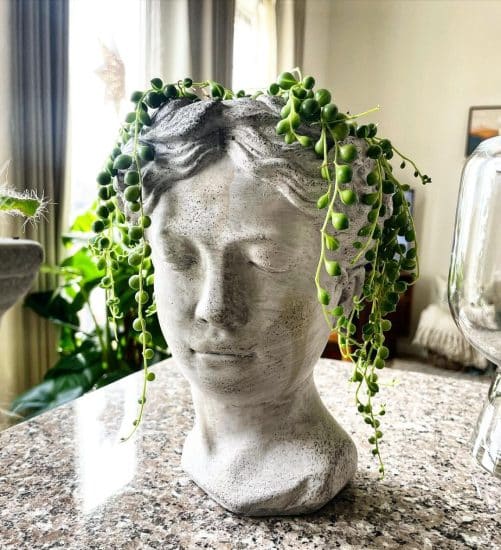
Not enough water and what happens? Your plant’s leaves might start to shrivel up, or you might even lose a few pearls (gasp!). Don’t let your plant go thirsty – it needs that stored water to stay perky and beautiful.
On the flip side, too much water can be detrimental too. Overwatering can cause leaves to get all mushy and rotten (yuck!). And we don’t want our string of pearls to turn into a string of mush, do we?
Temperature and humidity
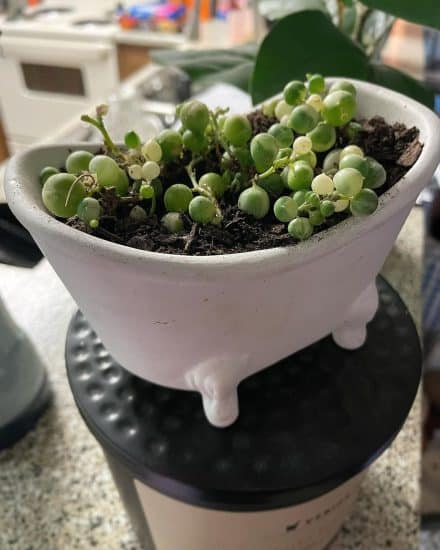
The string of pearls plant thrives in warm temperatures (70-80°F) during its growing season but prefers cooler temperatures (55-65°F) in winter.
It also enjoys medium humidity (40% or so), so it’s best to avoid placing your pearls plant indoors in humid areas like kitchens or bathrooms (and we don’t say that often around here!).
To ensure your string of pearls remains healthy, monitor its temperature and humidity conditions.
Signs of too much humidity include yellowing leaves, wilting, and mold growth. If you notice these symptoms, try relocating your pearls plant to a less humid room.
Conversely, if your plant’s leaves appear wrinkled or brown, it may need more humidity. Increase humidity by placing a small pebble tray with water near the plant or use a humidifier.
If your string of pearls experiences temperature stress (i.e., it gets too hot or cold) it may exhibit leaf drop or slowed growth. Keep the plant away from drafts, heaters, and air conditioning vents to prevent sudden temperature changes.
Temperature and humidity tips for your string of pearls plant:
- Maintain a temperature range of 70-80°F (21-27°C) during the growing season and 55-65°F (13-18°C) in winter.
- Keep your plant away from heat sources, such as radiators or heating vents.
- Avoid placing your plant in humid areas like kitchens or bathrooms.
- Use a digital thermometer and hygrometer (they’re cheap and very useful) to monitor temperature and humidity levels.
Soil and Planting
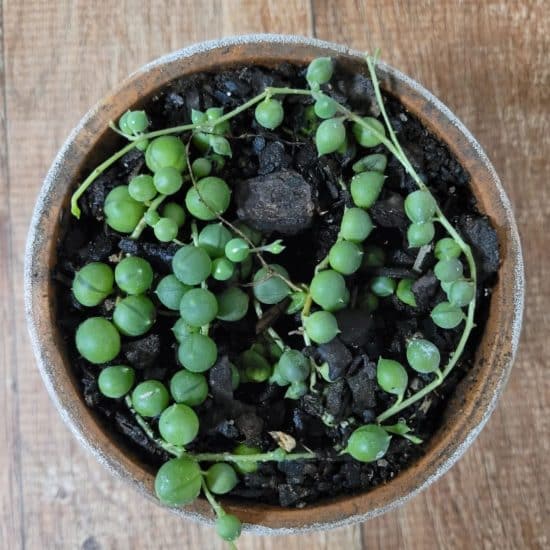
Choosing the right soil and pot for your string of pearls plant is essential. The pearls plant is known for its shallow root systems, which means it can be especially prone to root rot and does best with a well-draining cactus or succulent potting soil mix.
You can also create your own string of pearls potting mix with:
- 1/3 high-quality houseplant soil
- 1/3 perlite
- 1/3 silt/sand
As long as the potting soil combo you use drains well and gives your plant enough nutrients, it should be just fine.
Pruning
Use a clean pair of scissors or shears to cut off any dead pearls (creepy image!). You can also prune a leggy plant to shape it and make it bushier, since new growth will come from where you cut.
Plus, you can use the cuttings to propagate.
Repotting
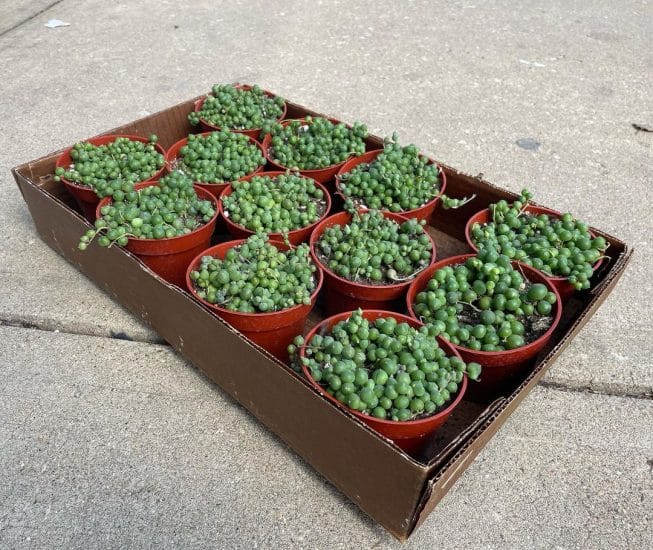
Your string of pearls plant will need to be repotted once a year or so. Make sure you use a slightly larger pot with good drainage — their shallow root systems need it!
Note that your plant can be repotted once a year, but it will eventually begin to die — and that’s totally normal. When this happens, after about five years, spend your energy propagating it rather than trying to save it! We’ll get to that in the next section.
Fertilizing
Fertilize string of pearls sparingly during the growing season, using a balanced liquid fertilizer diluted to half strength. Your plant doesn’t need to be fertilized in the winter when it’s dormant, and this might even harm its roots.
Signs of too much fertilizer include leaf burn, rapid growth, and weak stems. If you think this is the case, flush the soil with water to remove excess nutrients and fertilize sparingly in the future.
Our tips:
- Choose a well-draining pot, like an unglazed ceramic or terracotta clay pot, with ample drainage holes.
- Plant stems at the same level as or slightly lower than the pot’s top.
- To repot, gently remove the plant from its current pot, shake off excess soil from the root ball, and place it in a new pot filled with fresh succulent soil mix. Water the plant lightly to help it settle in.
Propagation Guide
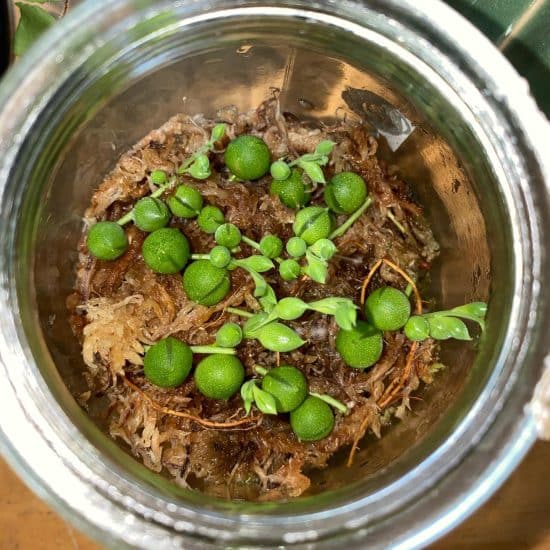
Ready to spread the love and grow a string of pearls plants? Propagation is simple. While you can use seeds, they’re not commonly available, and stem cuttings are the easiest route by far.
Propagate string of pearls by stem cuttings:
- With sterilized shears or scissors, cut a healthy stem off your plant, remove the bottom leaves, and let the cutting callus for a day or two.
- Fill a small pot with cactus potting mix or create your own, and make a snug hole for the cutting. Plant the stem in the hole, keeping the remaining leaves above the soil line.
- Put the pot in a bright indoor spot with indirect light or an area with partial outdoor sun. Keep the soil moist, but don’t water thoroughly for a few days to prevent rot. After that, water when the soil feels close to dry, as normal.
And that’s it! Pretty easy, right?
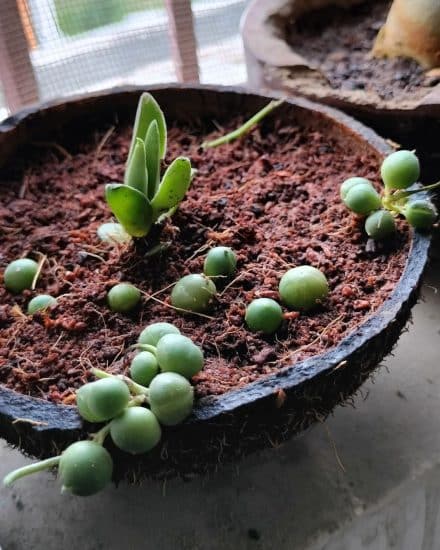
String of pearls propagation tips:
- Start with healthy, strong stems for the best chance of success.
- Be patient, since it might take a few weeks for roots to appear.
- Keep an eye on the cutting’s moisture levels to avoid rot or dehydration.
Common issues
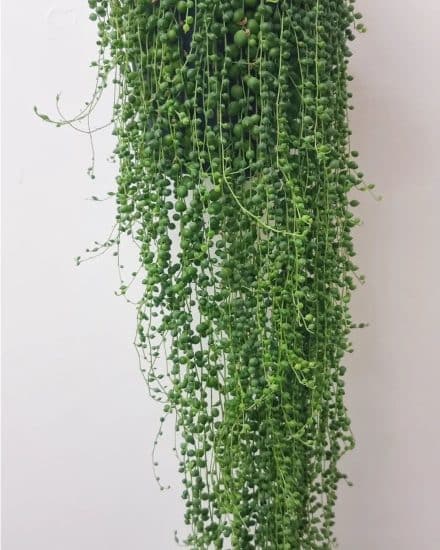
String of pearls may look different than other plants, but it suffers from the same common issues… which means it benefits from the same common solutions.
Shriveled leaves
If your string of pearls looks more like a string of raisins, you might be underwatering or overwatering. Check the soil — if it’s super dry, your plant is thirsty. If it’s constantly wet, you’re overwatering.
To fix this, adjust your watering routine. Water thirsty plants more frequently, or let the soil dry out more if you’re overwatering. And always use well-draining soil and a pot with drainage holes!
Leaves dropping off
Dropped leaves could mean your string of pearls plant is dealing with drafty or inconsistent temperatures. Pearl plants like stability, so temperature swings can stress them out.
Keep your pearls plant away from drafts, heating vents, or air conditioners.
Mushy stems
Mushy stems or purple leaves might mean overwatering, which can lead to rotting roots or soil-borne diseases. Too much water creates a playground for harmful fungi and bacteria that can wreak havoc on your plant’s roots and stems.
To solve this, cut back on watering and let the soil dry out almost completely between waterings. If the problem persists, you might need to repot your plant in well-draining soil and a container with more drainage holes.
Pests and Diseases
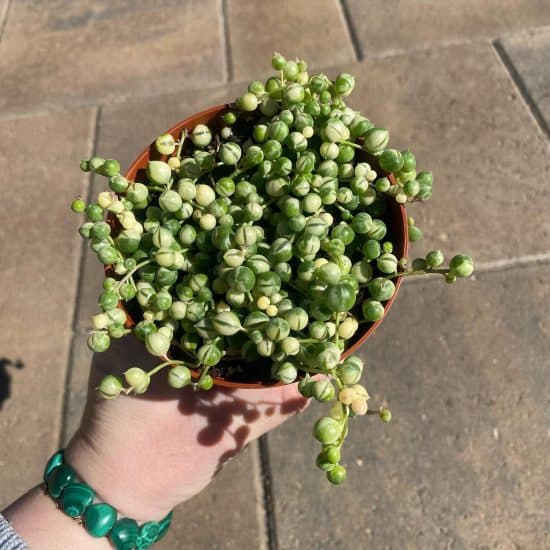
Root rot
Root rot is a common problem for string of pearls and so many others, often caused by overwatering or poor drainage. Symptoms include yellowing leaves, wilting, and a foul smell from the soil.
To treat root rot, remove the plant from its pot, trim away any damaged roots (they’ll be dark and mushy), and repot the plant in fresh soil that allows good drainage.
Prevent rotting roots by using a pot with drainage holes and a well-draining soil mix. Water your string of pearls plant only when the soil is dry one or two inches down. Remember, as a succulent, it can really go quite a while without water and loves a fast-draining soil!
Mealybugs and aphids
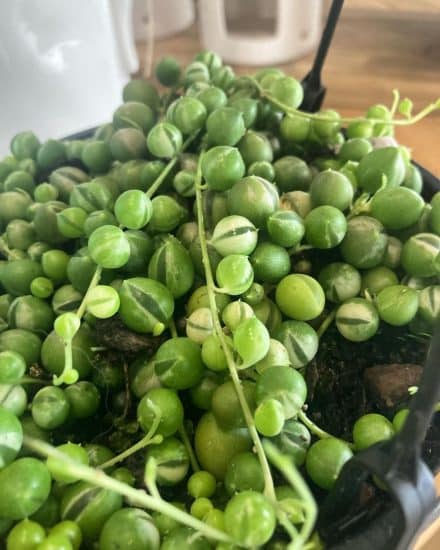
Mealybugs and aphids are common pests that can infest your string of pearls plant. These insects feed on plant sap, weakening the plant and potentially spreading diseases.
Signs of infestation include tiny bugs on leaves and stems, sticky residue, or distorted foliage (maybe even a combination).
To treat a mealybug or aphid infestation, isolate your plant from others so the issue doesn’t spread. Remove the pests by wiping the affected areas with a cotton swab dipped in rubbing alcohol.
For more severe infestations, treat your string of pearls plant with organic pest control methods like neem oil or insecticidal soap.
Regularly inspect your plant for signs of pests (including under its pearls) and try to catch infestations quickly so the problem doesn’t get worse.
Conclusion
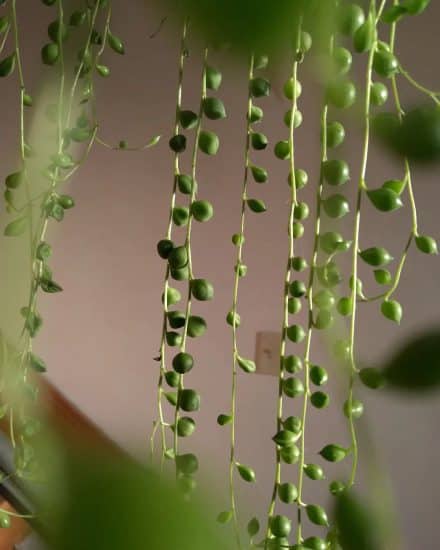
That’s a wrap for our string of pearls care guide! I’m clutching my pearls, this plant is so easy to take care of!
Senecio rowleyanus (okay, okay, Curio rowleyanus now) is unmistakable with those unique, pearl-like leaves, and it’s relatively easygoing to boot. String of pearls are a delightfully whimical addition to any indoor space.
By following our comprehensive care guide, you can ensure your string of pearls plant thrives and remains the enchanting focal point it deserves to be.
If you found this article helpful, share it with fellow plant-lovers. And please don’t hesitate to send us photos of your string of pearls plants — we love to see where you’ve put them!
If you have any questions about your plant, feel free to reach out to us on Facebook, Twitter, or Instagram.
Take care, and happy growing!
FAQ
Do string of pearls like to be misted?
No, string of pearls plants do not require misting. In fact, they prefer low-humidity environments. Misting can potentially lead to issues such as mold or rot, so it’s best to avoid this practice.
Are string of pearl plants easy to care for?
Yup, they’re relatively easy to care for and pretty popular indoors as well. They require soil that drains well, a mix of bright direct and mostly indirect light, and a low-maintenance watering schedule. Once you’ve established a routine, they can thrive with minimal effort.
How do you know when to water string of pearls?
Pearls that need water will be shriveled and fleshy-feeling. Pearls with enough water will be round and firm. You can also check the soil — if it’s dry a few inches down, it’s probably safe to water.
Does string of pearls need direct sunlight?
String of pearls plants prefer a mix of direct sunlight and indirect sunlight, with morning sun being the most beneficial. While they can tolerate some direct sunlight, don’t expose them to too much, or their pretty pearls might burn.
Does string of pearls do well if you plant outdoors?
String of pearls plants can be planted outdoors in USDA Zones 9 to 12, in areas that don’t drop below 50 degrees F at night. They’ll still need to be protected from harsh direct sun and put in well-draining soil.
If your local climate doesn’t fit the bill or you want to gaze at them adoringly all day, no sweat — grow them indoors instead!


